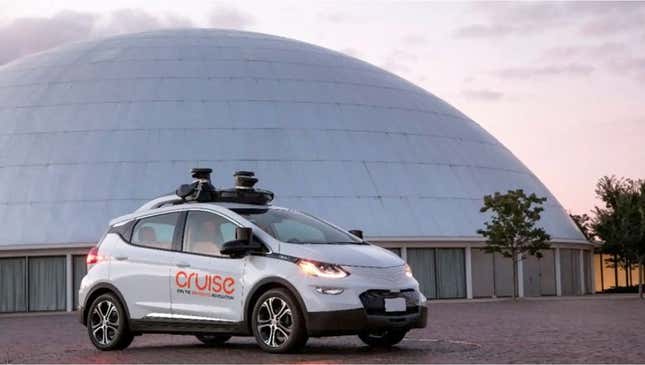
On June 28, streets in San Francisco came to a halt when self-driving Chevrolet Bolts operated by Cruise, GM’s self-driving company, sat motionless at red lights and in the middle of cross walks. The cars had no drivers, and trapped folks in traffic and riders in the vehicles alike. So what happened?
Wired took a deep dive into self-driving car failures in San Francisco and found the June 28 incident isn’t the first time Cruise cars randomly all stopped self-driving:
The June 28 outage wasn’t Cruise’s first. On the evening of May 18, the company lost touch with its entire fleet for 20 minutes as its cars sat stopped in the street, according to internal documentation viewed by WIRED. Company staff were unable to see where the vehicles were located or communicate with riders inside. Worst of all, the company was unable to access its system which allows remote operators to safely steer stopped vehicles to the side of the road.
A letter sent anonymously by a Cruise employee to the California Public Utilities Commission that month, which was reviewed by WIRED, alleged that the company loses contact with its driverless vehicles “with regularity,” blocking traffic and potentially hindering emergency vehicles. The vehicles can sometimes only be recovered by tow truck, the letter said. Images and video posted on social media in May and June show Cruise vehicles stopped in San Francisco traffic lanes seemingly inexplicably, as the city’s pedestrians and motorists navigate around them.
Cruise has been operating in the city since 2015, when its self-driving cars still required a driver at the helm. This year, Cruise is operating in over 70 percent of the city with specially selected public beta testers able to summon a driverless Cruise at will between the hours of 10 p.m. and 6 a.m. and only in clear weather (San Francisco isn’t known for its fog...right?).
Cars stopping dead after losing connection with the Cruise server isn’t just a bad look for Cruise — it might also disqualify them from the self-driving gam altogether. From Wired:
Losing connection with its vehicles, and especially its backup safety systems, might violate Cruise’s permits to operate in California, says Bryant Walker Smith, an associate professor at the South Carolina School of Law who studies autonomous vehicles. The California DMV program that regulates driverless cars requires a vehicle’s operator to certify that it has a link allowing for “two-way communications” between a vehicle—including its passengers—and an employee remotely overseeing the robot’s movements. However, much like autonomous cars themselves, regulations drawn up to apply to the vehicles have not been tested in every possible scenario.
Cruise did not respond to specific questions about its permits. Neither the California DMV nor the CPUC would say how Cruise’s permits might be affected by the outage incidents. The CPUC did not say whether it had responded to the anonymous Cruise employee’s letter, or taken its contents into consideration before approving the company’s permit.Regardless of Cruise’s legal obligations, Walker Smith says that self-driving companies should be open and transparent about what’s happening on public roads. “From the perspective of the public, when the vehicles do something wrong or weird, it’s on the company—the ‘driver’—to really explain it.”
So far, the stopped-dead vehicles have caused no injuries or crashes, just plenty of inconvenience. How long that luck will hold out, who can say? The entire story is a worrisome and eye-opening look at where one of the most successful self-driving car companies stands today and well worth your time. You can find it here.